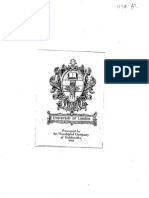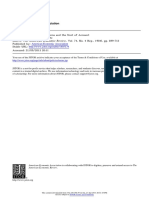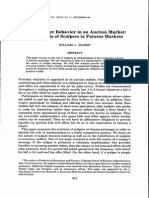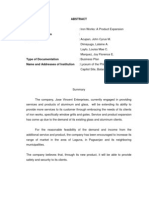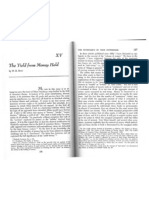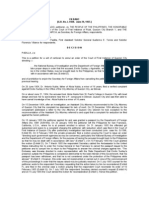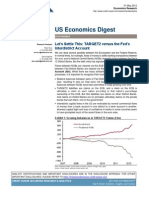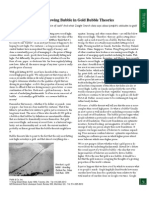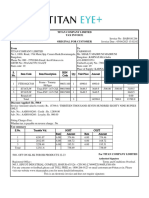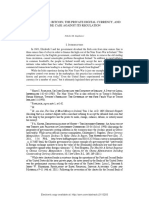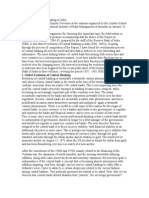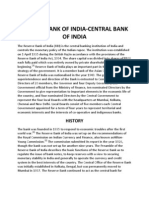MONEY IN AN ECONOMY WITHOUT BANKS : THE CASE OF IRELAND*
by ANTOIN E. MURPHY? Trinity College, Dublin Ireland is unique in the financial world for the prevalence and duration of its bank closures. Between 1966-76 industrial disputes resulted in the closures of the Associated Banks1 on three occasions in the Republic of Ireland. These closures, totalling in aggregate almost a year, provide economists with a unique opportunity of examining an economy functioning for long periods without the direct use of the major part of the money supply, bank deposits. Against the background of the six and a half months closure of 1970, it is intended:
(1) to examine the alternative money structure that arose during the closures;
(2) to investigate the extent to which the closures affected economic activity;
(3) to discuss the implications for monetary theory of these events.
THEALTERNATIVEMONEYSTRUCTURE
Current and deposit accounts with the Awociated Banks formed 82 per cent of Mz (currency and Bank deposits) in 1966,85 per cent in 1970 and 86 per cent in 1976. The bank closures therefore deprived the public of the direct use of, on average, well over 80 per cent of the money supply.
Manuscript recoived 10.8.77;final version received 27.2.78. t I tun indebted to Dr. Roger Chine (University of California, Berkeley) and Mr. T r n e Ryan (Trinity College) for their suggestions and assistance in eec preparing this psper. The usual disclaimer appliee. l 1These disputes involved the closure of al the offices and branches of the clearing beske in the Republic of Ireland. The Aamciated Banks are the Bank of Ireland, Allied Irish Benks, the Northern Bank and the Uleter Bank. The dates of the closures were: M a y 7-July 30, 1966 May 1-November 17, 1970 June 28-September 6, 1976.
41
�42
The Manchester School
Unfortunately, for puriyts in these matters, the closuree did not result in the suspension of all the means of payment w i t h the country. Irish currency and sterling continued to circulate. Some of the North American and merchant banks provided current account facilities to major companies, and in some cases alternative banking facilities were availed of in Northern Ireland and Great Britain. Table 1 shows the changes in currency and current accounts with institutions that remained open during the 1970 closure.
Table I Changes in Currency and Demand Deposits During 1970 Closure (Lrnillions)
(2)
May . . . . . . . . . . . . . . . June . . . . . . . . . . . . . . . July . . . . . . . . . . . . . . . August . . . . . . . . . . . . September . . . . . . . . . October . . . . . . . . . . . . Overall Change Source: Column I Column 2 and 3 Quarterly Bulletins of the Central Bank of Ireland. Irish Currency +9 +I Sterling
(3)
Current Accounts with Non-Associated Banks
+I
-3 -4 0
+3
+2
+I
+3 +2 +2
......
+4
4
+35
+ 13
Central Bank of Ireland Survey of Economic Effects of Bank Dispute 1970.
Column 1 shows changes in the amount of currency outstanding. The Central Bank was concerned to emure that adequate supplies of currency were made available to the public. Currency was transferred from the Central Bank to government departments MIas to meet the wages and salaries of employees in the public sector and also to meet social welfare payments. After the initial jump in currency in May of 9 million the demand for currency slackened off considerably. In the months of August and September the volume of currency outstanding fell by 7 million and at the end of the dispute there was only 4 million of currency more in circulation than at the start. Offsetting part of the additional demand for currency was the inrreased amount of sterling in circulation. Sterling is freely accepted as a means of payment in the Republic. It has been estimated by the Central Bank that there was a total of about 5 million in circulation in April 1970 and that this built up to 520 million by November with
�Illoney in an Econonty without Banke: the case of I r e h d
43
most of the increase coming from tourist expenditure during the Summer months.2 I n remaining open the non-Associated Banke, an amalgam of merchant and North American banks, did provide some transactors with a n alternative source for current account transactions. However, their ability to provide alternative means of payment was very limited, as these banks had no branch network system to operate within so that they found themselves physically incapable of dealing with the new volume of business presented to them. By the end of May most of them refused to handle new accounts. Current accounts with these non-Associated Banks only roBe by 13 &on during the closure. Some transactors were able to utilize bank accounts held in Northern Ireland and Great Britain. Unfortunately, there are no statistia available on these deposits. However, any outflow of funds to build up bank deposits outside the State in the weeks prior to the closure would have been reflected in a fall in the Republics official external reserves. No s i g d c a n t fall in the reserves was recorded indicating that such activity did not occur on any sizeable scale. Between the end of March and the end of May 1970 the official external reserves fell from 304 million to 301 million. I n some cams bank accounts outside the State were established and built up with the proceeds of export payments during the closure. These accounts were used to finance part of the import bill.3 Aggregating the known alternative source8 of payment money outlined in Table 1, i t may be seen that by November 1970 there was an additional f52 million of currency plus deposits in circulation. This does not include deposits held by residents outside the State. Taking it as a rough approximation it still only constituted less than one twelfth of the Associated Banks current and deposit accounts. This indicates that the alternative standard money made available in the form of currency and deposits cannot be held to have filled the gap created by the withdrawal of the direct use of the banks deposits from the system. The total of 5 billion of uncleared cheques at the end of the bank 3 closure was, by definition, the exchange medium that was used to finance most transactions. Cheques drawn on the Associated Banks
this sterling currency would normally have been collected by the Central Bank and inveeted i interest bearing billa and bonda in London, the dispute n resulted i 8 saving of over 1 million for the British Exchequer (8seuming n average excess sterling holdings of 1 7 6 million and an everage Treasury Bill rate of 6.9 per cent). 3Central Bank Survey (1971).
2As
�44
The Manchester Schoot!
continued to be the main transaction instruments used during the closure. However, it is important to note that the substance of the chequing transaction changed during the closure. In a normal banking system cheques are readily acceptable because it is believed that they are drawn against known accounts and will be cleared quickly. During the bank disputes they were drawn, not against known credit accounts or allowed overdraft limits, but against the value of other uncleared cheques and/or the transactors view as to his creditworthiness. Cheques cleared within a few days and against known accounts have little default risk attached to them or, if they are dishonoured, the mistake will not be repeated. Cheques accepted against uncleared cheques, debits issued against uncleared credits, greatly increased default risk. The acceptor of a cheque depended not only on the issuers creditworthinem but also on the creditworthinem of the latters payers. One transactors credit was contingent on anothers. A break in the credit link could, it was recognized, have a cumulative impact on the creditworthiness of other transactors. Uncertainty also existed because it was not known when the banks would re-open.4 In summary a highly personalized credit system without any definite time horizon for the eventual clearance of debits and credits substituted for the existing institutionalized banking system. The nature of the economy greatly facilitated the emergence of this new system. The Republic of Ireland has a population of only 3 million inhabitants. The small size of the population meant that there waa a high degree of personal contact amongst members of the community. Where information was lacking at the personal level substitute information storage units existed in the form of retail shops, numbering around 12,000 and, that well-known Irish institution, the public houae, 11,OOO of which exist in the Republic-a pub population (over eighteen) ratio of 1 : 190. It appears that the managers of theae retail outlets and public houses had a high degree of information about their customers-one does not after a l serve drink to someone for years without discovering l
4The public knew from the outaet of the 1970 closure that it would bo a prolonged one. The I&h T i m of May 16, 1970 reported that roughly 3.500 out of the total of 7,000 bank employees had taken up alternative work in London. P a e , aeemingly, were chartered to bring groups of benk employees to lns work in Britain! The speed with which employees accepted alternative temporary work waa indicative of the magnitude of the impasse between employers and employees.
�Money in an E:ccmomy without Banks: the case of Ireland
45
something of his liquid resources. This information enabled them to provide commodities and currency for their customers against undated trade credit. Public houses and shops emerged as a substitute banking system.
RISE CATEQORIES CHEQUES OF (GOVERNMENT VERSUS PRIVATE) Al cheques were not universctlly accepted. Cheques were graded l
inta various risk categories. Cheques drawn on the government and on well established institutions were readily accepted by the alternative banking system. I n many cases these cheques acted like certificates of deposit in that they changed ownership often during the closure. The negotiability of personal cheques depended on the degree of information and personal contact that the acceptor had about the issuer of the cheque. The high credit information content possessed by transactors in the community, a major factor facilitating the use of personal cheques, is borne out by the Central Banks Survey. The number of firms (retailers) who expressed concern a t the prospect of a large volume of unpaid cheques was small, despite the fact that a very large number of cheques was accepted by them. Through the dispute, Associated Bank cheques were freely accepted both within the country and, to a lesser extent, in respect of external payments. There is little evidence that firms or individuals experienced much difficulty in initiating domestic payments by drawing cheques on closed banks, but there was a reluctance to accept third party cheques. These types of statements run right through the Survey. They indicate the substantial amount of information transactors poseessed about one another. The ease witb. which transactions were carried out using this system is also exemplified by the fact that there was little evidence to indicate that bankers cards or similar facilities were used more intensively during the dispute of 1970. I n addition aome printing houses found that there was an active market for blank cheque books which they supplied to the general public through newsagents.
ECONOMIC ACTIVITY DURING THE CLOSURE To what extent did these three bank closures affect economic activity? For the 1970 closure the Central Bank and the Economic and Social Research Institute carried out a Survey of the economic effects of the bank dispute. The general picture derived from that Survey was that economic activity remained quite resilient throughout the six and a half month closure:
�46
The Mnnchater School
". . . the level of economic activity continued to increase, though at a reduced pace. . ." The conclusion reached by the Central Bank/ESRI was qualitative in nature. We wished to test the quantitative impact of the closure on expenditure. The monthly Retail Sales Index 1961-76 was taken as the best indicator of consumer expenditure.5 Having detrended this series, the average sales for each month between 1961-76, excluding the bank closure years of 1966,70 and 76, were calculated.6 The average sales for each month were taken to represent the expected retail sales. The recorded monthly retail sales for bank closure years were then compared with the expected retail sales to see if, aa a result of the closures, there was any statistically significant divergence of retail sales from what would have been expected-aee Table 2.
Table 2 Percentage Changes in Actual as Against Expected Retail Sales in the Bank Strike Years 1966. 1970 and 1976 (Strike Months are underlined) Year 1966 ... T Statistics
... 1970 ... ... T Statlstics ...
1976 ... T Statistics
Year 1966 ... t Statistics
...
January
+2*0% -9
+1.6%
February 1.4%
March
-5
-*I4% -1 +5*3% I *8
August +1*4% ,4
- 1.5% .6
+lag% *8 -4.9% 2 -0
April +2*I% *6
May
-2.3% I *07 -5.3 2*4* +.4% -2
June -4.9% 3.5*
.7
+3.8% I*I
-14% -4
- 3 -9%
2*8*
...
... ...
...
-.3%
I*
July -1.1% .4
+-2% I.
-10.4% 3.8* level.
September October +6.1% -1.0% 3.4*
a 3
November December +2% 1.4% -1 -3
1976 ... T Statistics
...
...
-4.2% I .I
+24% I *6
+*I% -02
+7.7% 2.6*
+4.9% 1.2
* Significant a t the 5%
5The emphasis had to be on retail sales because output statistica were available only on a quarterly baais and a further atrike in the cement industry during the 6rst half of 1970 caused major difficulties i interpreting the unemployn ment statistioe. 6The months were normalized by the yearly total and expressed at annual rates.
�Money in an E w m y without Banks: the case of Ireland
47
The results may be summarized as follows :
(1) I n eight out of the twelve bank closure months, actual retail sales did not significantly diverge from expected retail aales.
(2) I n four c a s e d u n e 1966, May and June 1970 and July 1976-there wa8 a significant fall in actual retail sales below expected retail sales.
(3) Caution needa t o be exercised in interpreting the 6 3 per cent . (May) and 3.9 per cent (June) fall in retail sales below expected sales in 1970. On May l a t of that year wholesale tax was doubled from 24 per cent to 6 per cent. Transactors had been notified of this change in taxation in April. It seems plausible to assume that the tax change caused transactors to push forward purchases of cars and heavy consumer durables to April so as to avoid the tax increase. T i change hs in taxation was a contributory factor to the downturn in retail sales in May and June.
(4) I n the case of the shorter closures of 1966 and 1976, there
was a pick up in retail sales some time after the re-opening of the banks. The deflationary effects of the 4.9 per cent (June 1966) and 10.4 per cent (July 1976) downturns in retail sales were offset by the 6.1 per cent (September 1966) and 7.7 per cent (November 1976) increases in actual above expected retail sales. There was no Significant upturn in retail sales a t the end of the 1970 closure.
It would seem reasonable to assume that if the public is deprived of the direct use of over 80 per cent of the money supply such a situation would create substantial deflationary forces in the economy. The evidence collected from the monthly Retail Sales Index suggests that this did not happen during the three bank closures. I n eight out of the twelve bank closure months retail sales were not significantly affected by the changed monetary circumstances. I n the other four months i t is noticeable that the downturn in retail sales took place a t the start of the closures. A similar learning process seems to have been a t work in each case with the initial deeire on the part of buyers to maintain liquidity, allied with the reluctance on the part of sellers to extend credit, giving way to the development of a huge multilateral system of credits and debits which permitted the smooth functioning of exchange activity as the closures lengthened.
�48
The ManChester School
IMPLICATIONS FOB MONETABYTHEORY It may be contended that there was no fundamental change in
the money system as a result of the closures. Transactors drew or accepted cheques of the Associated Banks in the belief that they would eventually re-open their doors to the public. Is there any fundamental distinction between chequw drawn on closed as against open banks? As was pointed out above, the substanceof the chequingtransaction underwent a fundamental change during the closures. Depositors were not drawing cheques against known accounts.7 They were drawing against their pre-closureaccounts plus the cheques they themselves had accepted. The payees accepted the cheque, not on the basis of a known bank deposit, but by virtue of the information they possessed about the creditworthiness of the issuer and the latters payers. Consider the case of a payee faced with the following:
(1) A cheque h u e d against a known credit account which may
be cleared with little delay through the clearing system.
( 3 ) A one/three/six months post dated, from the viewpoint of clearing, cheque.
The former is the type of transaction that takes place when the banks are open. Payment and exchange take place simultaneously. The second represents the situation payees faced during the closuresindeed transactors did not know at what date in the future cheques could be cashed, if at all. Shackle (1971) recent.ly pinpointed this essential distinction between money as a means of payment and money as a medium of exchange. Defining money in a payments context, Shackle maintained that one needed to d e h e payments first : Payment has been made when a sale has been completed. Payment has been made when the creditor has no further claim. Payment is in some sense final. . . the stock of money can be defined as the means of strictly simultaneous payment. Money, as a means of payment is, therefore, defined as that which iinalises a transaction either immediately (currency) or within the period required to clear a cheque (bank deposits).
7The asaumption that t m t o r s issue cheques against known accounts when the banks are open is not strictly accurate 88 cheques can and do on occasion bounce. The point made here is that the degree of trust and information required wea far greater during the closures.
�Money in an Economy without Banks: the m e o Ireland f
49
Money, as a medium of exchange does not finalise immediately the transaction process. It leaves the transactor and/or the accepting agency with some liability or contingent liability. Exchange takes place but payment is deferred. Time separates the act of payment from the act of exchange. As long &B exchange takes place, one can define a s money the instruments which have facilitated the exchange of goods and services. By using the concept of money as a medium of exchange, the range of items defined as money may be broadened to include instruments such as bills of exchange, IOUs and trade credit. Money in its means of payment role is largely required because it acts as a n information substitute. Once payment money is used the transaction is finalised and information on the creditworthiness of the payer is not required. On the other hand, money as a medium of exchange embodies a n information factor which allows exchange to take place prior to payment for goods and services. It is the information possessed by the payee on the creditworthiness of the payer which is vital to the transaction. Without adequate information the payee will demand means-of-payment money in return for his goods or services. This means that as information on the publics creditworthiness improves and aa institutionalized arrangements reduce the cost of acquiring information, exchange becomes less dependent on payment money.8 I n this way improved information may tend to increase the potential money supply by monetizing bills of exchange, IOUs, trade credit, etc. Due to improved information transactors may be more prepared to exchange goods and services on a deferred payments basis. I n other words, exchange may take place without the means of simultaneous payment.
CONCLUSION It is held that the bank closures in Ireland illustrate empirically the validity of the distinction between money as a medium of exchange and money as a means of payment as well as the importance of information in the exchange process. The direct use of means-of-payment money (bank deposits) was removed from the transaction process. In the absence of thie money, exchange activity remained relatively unaffected because the public was prepared to use undated trade credit
8It is of interest to note in this respect that some firms . , . particularly in manufacturing, feel following the ckepute that they can manage their &airs with relatively lower money balances i future. Central Bank Survey, n op. cat., p. 51.
�50
The Manehater School
aa the instrument of exchange. The publics ability to do so was based on the vast stock of information available to transactors on the creditworthiness of fellow transactors. Faced with the neceasity for finding alternative exchange instrumente, the public used undated trade credit, finding it a close substitute for payment money because of the information content on creditworthiness available in the economy.
REFEBENCES
Central Bank of Ireland (1971). Survey of Economic Effects of Bank Dispute 1970. Shackle, G. L. S. (1971). Discussion Paper on R. Clowers Theoretical Foundations of Monetary Policy in G. Clayton, J. C. Gilbert and R. Sedgwick (eds.), M o n d a y Theory and Monetary Policy in the 19708, Oxford University Press, pp. 32-34.




























